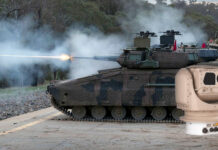Ground-based Midcourse Defense (GMD) demonstrates system-wide integration
The recent GMD intercept performed on December 5th 2008 demonstrated how the different pieces of the U.S. missile defense system could operate together spanning, over distances thousands of miles, cooperatively tracking, identifying, designating and engaging a ballistic missile target flying in space, eliminating it far above the atmosphere.
As the interceptor flew toward the target, it received target data updates from the GMD fire control system, which collected and combined data from four different sensors, the most ever for an intercept test. The sensors were the Aegis Long Range Surveillance and Track system in the Pacific; the AN/TPY-2 radar temporarily located in Juneau, Alaska; the Upgraded Early Warning Radar at Beale Air Force Base, Calif.; and the Sea-Based X-Band Radar (SBX) in the Pacific. After flying into space, the interceptor released its exo-atmospheric kill vehicle, which tracked, intercepted and destroyed the target warhead. This end-to-end test of the GMD system was the most realistic and comprehensive performed to date.
“Data gathered from multiple sensors gave us a clearer picture of the incoming threat, enabling GMD to achieve the shootdown of a complex target,” said Greg Hyslop, Boeing vice president and GMD program director. “Integrating sensors separated by thousands of miles is a major engineering challenge, but we overcame this challenge by working together as a team.”
The intercept of the simulated ballistic missile target demonstrated the maturity of currently established Ground-based Mid-Course Defense system. The network supporting the intercept comprised sensors, located over several continents. First to detect the threat was Defense Satellite Program (DSP), which spotted the launch. As the missile began its ascent, the Raytheon AN/TPY-2 X-Band long-range Radar stepped in. It acquired the target shortly after lift-off. Operating in forward-based mode from Juneau, Alaska, the radar continuously tracked the target throughout the engagement. The Air Forces’ Upgraded Early Warning Radar (UEWR) located at Beale Air Force Base, Calif., also tracked the target during its flight downrange.
Another sea based X-Band (SBX) Radar also participated in the test by tracking, discriminating and assessing the target. This radar is currently deployed in the Pacific Ocean off the coast of Hawaii. Its final deployment is scheduled in the waters off of Adak Island, Alaska, optimizing the coverage of the northern hemisphere, tracking ballistic trajectories originating from North Korea. The agency has already deployed X-Band radar in Shariki, Japan while other locations are being established in Israel and the Czech Republic, tracking potential threats originating from central and western Asia.
The Agency’s Track Interceptor, the Sea Based X-band radar (SBX) did the final tracking and was the primary sensor for the interceptor, to position itself for the intercept. It was the first intercept test in which data from SBX was combined with data from the other sensors to provide tracking-data and guidance aimpoint updates to the interceptor.
“This test confirms all three radars’ ability to provide integrated information to the BMDS in support of an intercept.” said Pete Franklin, vice president, National and Theater Security Programs for Raytheon Integrated Defense Systems. All radars employed by the system were designed by Raytheon. The Battle Management Command and Control in Colorado Springs at Shriver Air Force Base managed the integration and intercept of this test as it would do against a real missile threat from North Korea.
Additional part of the article: Missile Intercept Test Culminates a Successful Year for Missile Defense:
- GBD Ground Based Mid-course Defense Scores a Direct Hit
- Airborne Laser Tested at Edwards
- Radars, Sensors and Interceptor Cooperate to Bring Down Long Range Target Missile
- Exoatmospheric Kill Vehicles Tested for Missile Interceptor Upgrade
















